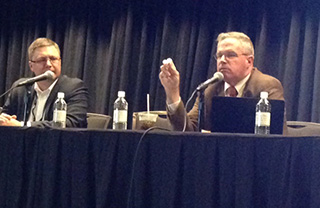The final rule for the new federal towboat inspection regulations is expected early next year, but there are many things towing companies should be doing now to prepare, experts told a WorkBoat Show conference seminar Tuesday.
“There’s a lot of very bad information about Subchapter M on the streets — a lot of misunderstanding and myths,” said Ian McVicker, towing vessel coordinator at ABS Group, Paducah, Ky. “So we must focus on education.”
McVicker joined Kevin Gilheany, owner, Maritime Compliance International, to discuss some of the key aspects of the evolving rule, known as Subchapter M. The rule will require towing vessels to comply for the first time with a host of national inspection and safety rules with the aim of making the towing industry safer.
There are three main parts to compliance — vessel standards, drydock exams, and a third-party safety management system. “All of those parts must be met by compliance,” McVicker said.
He said one of the most important things that companies can do in advance of the final rule is to study the proposal and prepare all components of their business to be in compliance. He said it’s unlikely that the final rule will differ much from the proposed rule.
He also suggested talking to a company’s partners, asking shipbuilders, for example, if they are prepared for the rule and the work that will relate to it, and make sure that the timeline for compliance is understood. There will be a two-year implementation period after the final rule is published, after that, there will be a compliance phase-in period.
In addition,companies should understand what the vessel standards of the rule expect, assess their vessels accordingly and fix any gaps to assure compliance. This could include checking for watertight integrity, visibility from the pilothouse, emergency escape, and ventilation for accommodations.
“The best thing that companies can do is educate themselves about the rule, or have someone go through it with them. They could also meet with the Coast Guard Towing Center of Expertise,” McVicker said.
The new inspection regime, authorized under the Coast Guard and Maritime Transportation Act of 2004, has taken more than 10 years to design, refine and finalize. The towing industry has played a major role in shaping the program.





